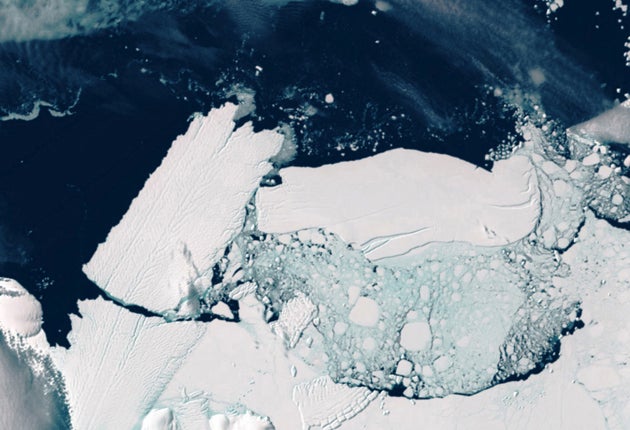Giant iceberg breaks free from Antarctic in collision

Your support helps us to tell the story
From reproductive rights to climate change to Big Tech, The Independent is on the ground when the story is developing. Whether it's investigating the financials of Elon Musk's pro-Trump PAC or producing our latest documentary, 'The A Word', which shines a light on the American women fighting for reproductive rights, we know how important it is to parse out the facts from the messaging.
At such a critical moment in US history, we need reporters on the ground. Your donation allows us to keep sending journalists to speak to both sides of the story.
The Independent is trusted by Americans across the entire political spectrum. And unlike many other quality news outlets, we choose not to lock Americans out of our reporting and analysis with paywalls. We believe quality journalism should be available to everyone, paid for by those who can afford it.
Your support makes all the difference.An iceberg the size of Luxembourg has broken away from the Antarctic continent and is drifting towards an area of the Southern Ocean that plays a critical role in driving the world's ocean circulation – the global "conveyor belt" of circulating sea water.
The floating iceberg, which contains enough fresh water to supply a third of the world's population for a year, is 48 miles long, 22 miles wide, has a surface area of 965 square miles and an average thickness of 1,300 feet. It is one of the largest icebergs to be monitored by scientists.
Researchers believe the iceberg may be big enough to interfere with the flow of extremely cold and salty water that naturally sinks to the seabed in this part of the southern hemisphere to form the deep current of water that is transported around the world along the sea floor.
This ocean circulation transports heat and nutrients and is vital for the marine food chain as well as maintaining important currents, such as the Gulf Stream
The giant iceberg broke away from the Mertz Glacier tongue in East Antarctica about three weeks ago. The "calving" occurred when another, equally large, iceberg rammed against the Mertz Glacier tongue. "The calving itself hasn't been directly linked to climate change but it is related to the natural processes occurring on the ice sheet," Rob Massom, a scientist at the Australian Antarctic Climate and Ecosystems Co-operative Research Centre in Hobart, Tasmania, told the news agency Reuters.
Mike Meredith, of the British Antarctic Survey, said the drifting iceberg is unlikely to completely interrupt the global ocean circulation. "This bottom water formation occurs in several places... It is unlikely that we'll see any impact on the global climate," he said.
Join our commenting forum
Join thought-provoking conversations, follow other Independent readers and see their replies
Comments